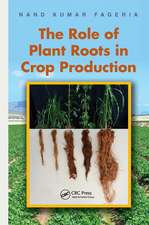Comparative Epidemiology of Plant Diseases
Autor Jürgen Kranzen Limba Engleză Paperback – dec 2010
| Toate formatele și edițiile | Preț | Express |
|---|---|---|
| Paperback (1) | 940.72 lei 43-57 zile | |
| Springer Berlin, Heidelberg – dec 2010 | 940.72 lei 43-57 zile | |
| Hardback (1) | 946.87 lei 43-57 zile | |
| Springer Berlin, Heidelberg – 4 sep 2002 | 946.87 lei 43-57 zile |
Preț: 940.72 lei
Preț vechi: 1147.21 lei
-18% Nou
Puncte Express: 1411
Preț estimativ în valută:
180.00€ • 188.44$ • 148.94£
180.00€ • 188.44$ • 148.94£
Carte tipărită la comandă
Livrare economică 07-21 aprilie
Preluare comenzi: 021 569.72.76
Specificații
ISBN-13: 9783642078248
ISBN-10: 3642078249
Pagini: 216
Ilustrații: VIII, 206 p.
Dimensiuni: 155 x 235 x 11 mm
Greutate: 0.31 kg
Ediția:2003
Editura: Springer Berlin, Heidelberg
Colecția Springer
Locul publicării:Berlin, Heidelberg, Germany
ISBN-10: 3642078249
Pagini: 216
Ilustrații: VIII, 206 p.
Dimensiuni: 155 x 235 x 11 mm
Greutate: 0.31 kg
Ediția:2003
Editura: Springer Berlin, Heidelberg
Colecția Springer
Locul publicării:Berlin, Heidelberg, Germany
Public țintă
ResearchCuprins
1 Introduction.- 2 Plant Disease Epidemiology and the Scope of Across Comparison.- 3 On the Methodology of Comparative Epidemiology.- 4 Comparative Epidemiology at the System Levels Host and Pathogen.- 5 Comparison of Temporal Aspects of Epidemics: The Disease Progress Curves.- 6 Comparison of Spatial Aspects of Epidemics: Gradients and Spatial Distributions.- 7 Comparison of Effects of Epidemics.- References.
Recenzii
From the reviews:
"The book presents examples of across-studies in the area of plant diseases … . The book is recommended not only as a tool for a better understanding of criteria, methods and procedures, but also as a comprehensive compilation of examples from the area of plant disease epidemiology in the light of comparative epidemiology. Additionally, the book includes … innovative suggestions, including a discussion on equivalence tests and meta-analysis. … Altogether, this book is a very helpful tool in studying and understanding comparative epidemiology." (J. Pons-Kühnemann, Journal of Phytopathology, Vol. 151, 2003)
"The book presents examples of across-studies in the area of plant diseases … . The book is recommended not only as a tool for a better understanding of criteria, methods and procedures, but also as a comprehensive compilation of examples from the area of plant disease epidemiology in the light of comparative epidemiology. Additionally, the book includes … innovative suggestions, including a discussion on equivalence tests and meta-analysis. … Altogether, this book is a very helpful tool in studying and understanding comparative epidemiology." (J. Pons-Kühnemann, Journal of Phytopathology, Vol. 151, 2003)
Textul de pe ultima copertă
Comparison is a powerful cognitive research tool in science since it does "across studies" to evaluate similarities and differences, e.g. across taxa or diseases. This book deals with comparative research on plant disease epidemics. Comparisons are done in specifically designed experiments or with posterior analyses. From the apparently unlimited diversity of epidemics of hundreds of diseases, comparative epidemiology may eventually extract a number of basic types. These findings are very important to crop protection. Plant disease epidemiology, being the ecological branch of plant pathology, may also be of value to ecologists, but also epidemiologists in the areas of animal or human diseases may find interesting results, applicable to their areas of research.
Caracteristici
Unique feature of the book is its comparative approach Includes supplementary material: sn.pub/extras






